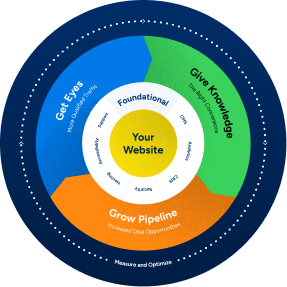When it comes to advertising and marketing in the modern economy, search engine optimization (SEO) is one of the most powerful tools businesses have at their disposal. It’s also commonly thought to be one of the most complex and complicated marketing processes to execute properly. Much of the complexity and difficulty stems from marketers chasing SEO trends and trying to keep up with changes Google and other search engines make to search engine algorithms. Those who have been in the SEO game for a while, however, remember when one of Google’s Search Quality Senior Strategists dropped a bomb on the marketing community revealing that, in addition to Google’s proprietary AI RankBrain, the two most important ranking signals for a website are amazing content and strong, relevant backlinks.
In this blog, the SEO team at Boston’s premier B2B marketing partner, GoingClear, breaks down some specific ways we can help you to integrate common SEO solutions in order to boost the two ranking signals that are easiest to influence.
Create Great Content
Posting strong, informative, and localized content to your webpage is the most important thing you can do in establishing the foundations of your website’s SEO. In the past, your website acted as a bulletin board on the side of the information highway, providing visitors with a basic overview of products and services. The goal of modern content strategies is to be the book your visitors come back to over and over again to learn more about relevant industry trends, your organization’s community involvement, or even new products you might have in the works. And the best way to catch potential clients’ attention is by creating content utilizing the same keywords they’re using in search engines.
Researching the Right Keywords for Your Brand
SEO optimization starts with the basic premise that you need to be the kind of content your target clients will be searching for in a search engine. This is accomplished by incorporating relevant and extremely targeted keywords into your content. One of the best tools businesses can use to plan out what keywords they should be using is the Google AdWords Keyword Planner, which provides insight into how often relevant words appear in searches and provides suggestions for related keywords. The keyword planning tool can be used in conjunction with the Google Search Console, which provides insight into the keywords already leading visitors to your site. Together, these tools will help your team to write natural and engaging content that is sure to catch the attention of the types of readers you’re looking to attract.
Focusing on Local, Focusing on Your Service Area
While keywords will go a long way towards helping boost your site’s search engine performance, there is another key to modern content strategy you need to take into account when crafting your content. From 2016-2018, Google released consumer insight data showing a more than 900% increase in searches for “near me tonight/today,” which shows how important it is to focus on localizing your content to the city or cities in which you provide services. By tying your business to a city, you will gain ranking when people in that geographic area search for the goods or services you provide.
When we talk about localizing your website and its content, we mean more than mentioning the cities in which you do business in blogs. You can also create location-specific service pages within the structure of your site. By creating a location page for each city or neighborhood in which you do business and populating that page with unique and engaging information about your brand and products or services, you’re giving search engines even more content to discover and more ways for potential clients to find your business.
Backlinks
Creating strong, relevant backlinks is the process of improving your website’s search engine ranking performance by ensuring that the right websites are linking back to content on your website. There are two levels to backlinking that are important: claiming your virtual real estate across directories, social media, and review sites, and leveraging business relationships in order to gather backlinks from influential partners and organizations you sponsor.
Claiming Your Virtual Real Estate Across the Internet
In the modern marketing landscape, your brand is more than your website. All across the Internet are both free and paid virtual spaces with your name already on them. If you don’t tend to this virtual real estate that has been gifted to you, traffic to your website will be minimal. Boost your brand’s exposure and website traffic by focusing your efforts on these three outlets:
- Your “Google My Business” account. You can create a free listing on the leading search engine’s directory that includes information about your business with a logo and images. You can create listings for each location you manage, helping to capitalize on the localization strategies we discussed previously.
- Online directories and business listings. Aside from search engines, there are numerous industry-specific and general online business directories you can create accounts on in order to create free listings. Start with Hubspot’s listing of online and local directories and work your way out from there.
- Social media platforms. While there is some overlap in the Hubspot listing above, it’s important to highlight the necessity to focus on your brand’s social media presence. Not only do these platforms give you the perfect inbound marketing channels, they also allow you to create directory listings that have extremely high visibility.
When working to build your online presence across the web, it’s important that all of your listings NAP information matches your physical business location or locations. Referring to your business’s name, address, and phone number, inconsistent NAP information across your various directory listings will cause search engines to penalize your business in search results.
Also crucial across your directory and business listings are those sites that host business reviews. Within your inbound marketing strategy, you should be dedicating resources towards inviting and curating product and customer reviews. The social proof traffic you will generate simply from word of mouth will help to boost your website in results pages tremendously.
Leveraging Existing Relationships, Influencers, and Partnerships
In addition to the various directories and social media listings, you should also be working with your existing clients, influencers on social media platforms, and organizations you support.
GoingClear Knows SEO
There are many technical aspects to SEO that your B2B marketing partners at Boston-based GoingClear can help to build into the inner workings and structure of your website. However, it’s not all about what’s going on behind the scenes. GoingClear can help your business to improve its SEO performance by helping to plan out proper content and integrate localization strategies, as well as help craft a backlinking strategy that works for your organization.

